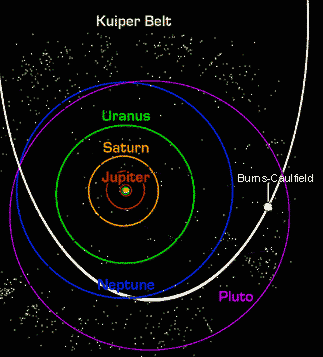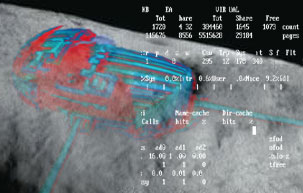Burns-Caulfield Critical Update: Burns-Caulfield Destroyed
| Abstract: | the artefact detected beneath the surface of the Burns-Caulfield comet has evidently self-destructed at the approach of the Second Wave. | ||||
| Context: | On 18/04/2082 the French deep-space cometary survey probe Boule de Neige-IX intercepted an unidentified 21-cm tightbeam radio signal sweeping the sky with a periodicity of 4.57 seconds. The signal was subsequently tracked to a transNeptunian Kuiper Belt Object dubbed Burns-Caulfield, an otherwise unremarkable comet (albeit with an unstable orbit). Initial flybys by a pair of high-velocity probes (the First Wave) revealed the presence of a subsurface artefact consisting largely of refined iron. Three more-elaborately-equipped probes (the Second Wave) are currently on final approach for extended high-resolution survey work. A crewed ship (Theseus, aka the Third Wave) is following in turn, but is limited by the accellerative constraints imposed by a live crew; it is still in midsystem. | ||||
 Approximate location of comet Burns-Caulfield upon detection on 18/04/82. Compositionally, Burns-Caulfield is a Kuiper Belt Object notwithstanding its projected long-period orbit, which appears to have been recently disrupted prior to detection. |
Looped realtime footage of Burns-Caulfield during self-destruct, taken by SW-01 during final approach. Subsurface artefact is briefly visible prior to detonation via enhanced false-color radar imagery.
|
||||
| Update: | Burns-Caulfield has been destroyed by an explosion epicentered near its core. Detonation occured at 1436:12/02/2084 GMT, immediately following initiation of subsurface radar mapping by the Second Wave. This raises the possibility of a deliberate self-destruct triggered by our probes, perhaps as a xenophobic measure to prevent proprietary technology from falling into potentially hostile hands (i.e., ours). It is true that active scans during the First Wave flyby evoked no such response (or, in fact, any response at all). However, the signals emitted by the Second Wave were over twice as intense and were triple-sourced, for hologramatic remixing and vastly improved resolution. Additionally, while the First Wave accellerated continuously past their target, the Second Wave was in the process of braking for an extended orbital survey. The prospect of more comprehensive surveillance may have exceeded some tolerance threshold not met by the more superficial scans conducted during the previous flyby. | ||||
| |||||
It is also possible that the explosion had nothing whatsoever to do with the approach of the Second Wave. Coincidences do happen. It would not, however, be prudent to adopt this as a working assumption. | |||||
| Recommendations: | There is no point in Theseus continuing on her current course: the destination no longer exists. At the moment, however, no other destination presents itself. If the BC artefact was, in fact, a diversion, it stands to reason that we were being diverted from something. We would therefore recommend a redoubling of outersys survey efforts, with particular focus on the region of the sky opposite Burns-Caulfield. Thanks to her lack of onboard fuel constraints, Theseus can be redirected en route to any late-breaking target within a light year's distance. Antimatter production at the Icarus Array has already been increased by 50%, and will be operating at twice nominal capacity within the week in the event such an extended voyage proves necessary. In the meantime, we recommend a standby cometary trajectory. | ||||




